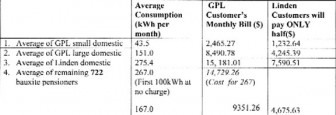Dear Editor,
The incorporation of the Linden area into the national electricity grid was advocated decades ago. It is a natural step in the growth and development of Linden. The merger of all service areas, and the incorporation of Linden into the national electricity grid, is the final step in the journey of the citizens of Linden, and Linden itself, from being all just bauxite employees living in a bauxite town, to self-sufficient Guyanese living in the second town in Guyana.
Yes, there will be challenges in this final step of transformation as citizens leave behind the very highly-subsidized electricity rates to come under the umbrella of the national grid, but it is a necessary step if lives and businesses in Linden are to be built on a sound basis and not to be constantly constrained by the quantities of money available through annual budgetary allocations in order to subsidize electricity in Linden.
The citizens of Linden are not being asked to cover the costs of electricity generated in Linden, which now based on diesel, is higher than the cost of heavy fuel oil (HFO), the major fuel of GPL at this time. As we all know, the tariffs of GPL have been greatly subsidized in this year’s budget, and government is doing all that it could to quickly make available hydro-electricity at the lowest possible sustainable cost. Citizens in Linden will share in all support/subsidy to the national grid – (GPL) – and, initially, customers in Linden will be required to pay only half of the bill. Full payment would not be implemented before the beginning of 2016, when hydro-electricity is expected to be available.
To be more specific, as of July 1, 2012, customers in Linden, in domestic categories, would see the following:
Note that, for the remainder of 2012, Linden customers are being asked to pay only half of what customers in Bartica, New Amsterdam, Corriverton, Anna Regina, Georgetown and elsewhere will normally pay.
Note, also, that Linden domestic customers consume over two times what domestic customers (including pensioners) consume on the GPL grid. The very low cost of electricity in Linden has long prevented any incentive for customers in the mining town to reduce energy consumption, with the consequent reduction in billings. There is potential for significant reduction of consumption by Linden consumers, towards the averages in the GPL grid.
Far from what provocateurs and detractors in the opposition say, beyond this particular subsidy, which averages $17,000/month ($204,000/year) per domestic customer, Linden has been sharing equitably in what the government has been able to provide to citizens all across Guyana – improvements in roads, in schools and in schooling, in hospitals and in health services, in modernizing the traditional economic sectors, and in encouraging and enabling new and emerging sectors. Linden has not been forgotten, nor has Linden been lagging behind!
This government has handled the challenges of transforming and modernizing an old, loss-making bauxite location, sensitively, injecting over $3 billion to meet shortfalls in the provisions of the bauxite operations that it inherited, shortfalls in workers’ savings schemes, NIS payments, PAYE and pension payments, and in meeting termination benefits of workers, as the previously nationalized bauxite companies were wound up. Government is heartened that the refashioned bauxite companies, with leading international partners, are looking again to sustainable, profitable operations and expansions.
Linden, like places all over Guyana, is at a point of ‘take-off.’ Within the year, there would be a number of opportunities of which citizens of Linden should seek to take advantage and, through which,Linden would be further enhanced’ viz:
* The construction of the Amaila Falls Hydro-electric Plant, which should begin with all materials passing through Linden and, also, with the main contractors based in Linden.
* The expansion of the BOSAI operations, with construction of a new kiln and the installation of facilities for new products, such as mullites and proppants.
The dust problem of many decades, in Linden, should be brought to an end with the installation, by BOSAI, of adequate bag filtering units.
* The transshipment of woods through Linden by Bai Shan Lin Company and other wood operations. Bai Shan Lin has begun works on a large wood-processing facility at Conception, just south of Moblissa on the Demerara River.
* The US$12 million project to rebuild, upgrade and extend the water supply in Linden. *Maintenance of the Linden-Lethem Road, with branches to the south and to the Pakaraimas in the north, bolstering the development of Linden as a gateway to southern Guyana and northern Brazil.
* A small call centre has been operating in Linden for almost two years now. Government had persisted in finding a developer after another, among the first three, proved unsuccessful.
* The new optical cable from Lethem to Georgetown passes through Linden, and a ‘drop-off’ point has been provided.
Calls for the destruction of any infrastructure in Linden, such as roads, and the shutting-down of the town, are self-wounding, as they would threaten bright economic prospects for the mining town. I wish to urge my fellow Lindeners to accept this reform as the inevitable final step in the transformation of Linden from a company town into a truly national town!
Yours faithfully,
Samuel A A Hinds, MP
Prime Minister and Minister of Energy


